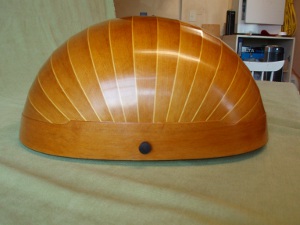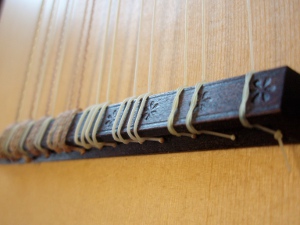 8 course lute after the C45 Tieffenbrucher, 62.5 cm
8 course lute after the C45 Tieffenbrucher, 62.5 cm
 8 course lute after the C45 Tieffenbrucher, 62.5 cm
8 course lute after the C45 Tieffenbrucher, 62.5 cm
The body of this lute is slightly reduced (95%) from the original in the Vienna KHM;
this allows for a longer string length than one normally sees for 8c lutes, and also
allows for 9 tied frets. The body is slightly larger than most g' lute models, which
gives it the capacity for a full bass sound (this model was designed with gut basses in
mind, and either gimped or pistoy strings work very well). It has the subtlety and
dynamic range needed for solo work, as well as the power and projection to stand its
place in ensembles and as an accompaniment to voice. For the repertoire of the English
and Continental "Golden Age", I would call this my most 'compleat' lute model.
I also make this lute as a 9 course model, and as a 10 course with a string length of
64 cm.
The back is of 17 ribs, either dark yew with sycamore spacers, or striped yew without
spacers. The neck and pegbox are veneered in ebony, and there is an ebony edge
binding on the belly.
 |
 |
 |
This model is based on the lute dated 1592 by Vendelio Venere in the Accademia Filarmonica,
Bologna, one of the very few lutes to have come down to us in a virtually unaltered state.
The original has 25 dark yew ribs with light-coloured spacers; I have redesigned it
as a 13-rib model, following the example of other Paduan lutes of the period.
The string length is 58.5cm, and tunes in modern g' or low pitch a'. The model shown has dark yew ribs with holly spacers, but it can also be built with hardwood ribs (such as curly maple) with dyed-black poplar spacers.
Fingerboard, points, and soundboard edge binding are of ebony, and the pegs are of dyed-black castella boxwood. The model shown has a neck and pegbox of pear, but is also available with ebony veneers on the pegbox and neck. |
Travis Carey, Luthier
207-8696 Barnard Street
Vancouver, BC V6P 5G5
Phone 778-554-3634
604-872-8522
email: tcarey@sasktel.net